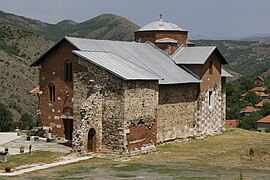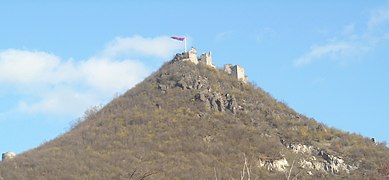Zvečan
Zvečan
Jump to navigation
Jump to search
| Zvečan | ||
|---|---|---|
Town and municipality | ||
 Panorama of Zvečan | ||
| ||
 Location of the municipality of Zvečan within Kosovo | ||
Coordinates: 42°54′N 20°50′E / 42.900°N 20.833°E / 42.900; 20.833Coordinates: 42°54′N 20°50′E / 42.900°N 20.833°E / 42.900; 20.833 | ||
| Country | Kosovo[a] | |
| District | District of Mitrovica | |
| Settlements | 36 | |
| Government | ||
| • Provisional president | Vučina Janković (GIS) | |
| Area | ||
| • Total | 122 km2 (47 sq mi) | |
| Elevation | 461 m (1,512 ft) | |
| Population (2015) | ||
| • Total | 16,650 | |
| • Density | 140/km2 (350/sq mi) | |
| Time zone | CET (UTC+1) | |
| • Summer (DST) | CEST (UTC+2) | |
| Postal code | 38227 | |
| Area code(s) | +383(0)28 | |
| Car plates | 02 | |
| Climate | Cfb | |
| Website | www.opstinazvecan.rs | |
Zvečan (Serbian: Звечан; Albanian: Zveçan) is a town and municipality located in the Mitrovica District in Kosovo[a]. As of 2015, it has a population of 16,650 inhabitants.[1] It covers an area of 122 km2 (47 sq mi), and consists of a town and 35 villages.
Zvečan is a part of North Kosovo, a region with an ethnic Serb majority that functions largely autonomously from the remainder of ethnic Albanian-majority Kosovo. After the 2013 Brussels Agreement, the municipality became part of the Community of Serb Municipalities.
Contents
1 History
2 Demographics
2.1 Ethnic groups
3 Geography and infrastructure
3.1 Location
4 Economy
5 Culture and education
6 Gallery
7 See also
8 Notes and references
9 External links
History[edit]
The town of Zvečan is located near Mitrovica. It was mentioned for the first time in connection with the border clashes between the Serbs and Byzantines between 1091 and 1094. There is also an inscription that Grand Prince Stefan Nemanja, after the victory over the Byzantines in 1170, ordered that a prayer for the successful outcome of the battle be held in the church of St George at Zvečan.
In the 13th and 14th centuries Zvečan was one of the royal residences of the Serbian court. Queen Theodora died there in December 1322, and nine years later her husband, Stefan Uroš III was imprisoned and strangled there.[2]
First, the Musić, then the Vojinović noble family, held the fortified city and region during the Serbian Empire of Uroš V (r. 1355–1371). As imperial power collapsed Zvečan was in a disputed zone being held by Miloš Pović in 1370 but claimed by Nikola Altomanović.[3]
In 1389, after the Battle of Kosovo, it was integrated into the Ottoman Empire and later became part of the Sanjak of Novi Pazar.[4]
From 1878 to 1908 it, along with the rest of the Sanjak, was administered by the Austro-Hungarian Empire as a result of the Congress of Berlin. But in 1908 it was returned to Turkey.[citation needed]
On the highest spot, i.e., the Upper Town, there are remains of St George's church, cistern and the main octagonal tower. The ramparts of this part of the fort are reinforced by massive towers. The main entrance to the town was on the western side.[citation needed]
Demographics[edit]
| Historical population | ||
|---|---|---|
| Year | Pop. | ±% p.a. |
| 1981 | 8,675 | — |
| 1991 | 10,030 | +1.46% |
| 2015 | 16,650 | +2.13% |
According to the 2011 estimations by the Government of Kosovo, Zubin Potok has 1,838 households and 7,481 inhabitants.[5] In 2015 report by OSCE, the population of Zvečan municipality stands at 16,650 inhabitants.[1]
Ethnic groups[edit]
The majority of Zvečan municipality is composed of Kosovo Serbs with around 16,000 inhabitants (95.1%). Also, there are 500 Kosovo Albanians and 300 inhabitants of other ethnicity.[1] About 3,750 Kosovo Serbs are located in the municipality as Internally displaced persons (IDPs) as well as 250 refugees from Croatia. Most of Kosovo Albanians live in the villages of Boletin (Boljetin), Lipë (Lipa) and Zhazhë (Žaža).
The ethnic composition of the municipality of Zvečan, including IDPs:[1]
| Ethnic group | 2015 est. |
|---|---|
| Serbs | 15,850 |
| Albanians | 500 |
Bosniaks, Romani, Gorani | 300 |
| Others | - |
| Total | 16,650 |
Geography and infrastructure[edit]
Location[edit]
Novi Pazar (48 km) | Leposavić (29 km), Raška (60 km), Kraljevo (140 km), Belgrade (300 km) | |
Zubin Potok (22 km) |  | Podujevo (47 km) |
Srbica (26 km), Istok (51 km), Peć (72 km) | Prizren (107 km) | North Mitrovica (3 km), Vučitrn (16 km), Pristina (45 km), Gračanica (49 km) |
Economy[edit]
The largest employer in Zvečan is the lead and zinc melting factory “Trepča”. Its large smokestack is with 306 meters the tallest structure in Kosovo. Due to the serious environmental pollution from the factory, however, UN and KFOR shut it down and the only ongoing operation is alloy production for batteries and battery recycling. Once employing up to 4,000, the very low operations of “Trepča” has had a devastating effect on the local economy. Today, in the municipality only about 500 people are working at 60 small private companies and 150 shops.[1]
Culture and education[edit]
The Faculty of Arts, part of the University of Pristina at Mitrovica, is situated at Zvečan.
Zvečan has hosted annually two international music festivals: The North City Jazz & Blues Festival,[1][6][7][8][9][10][11][12] and international rock festival Overdrive,[13] as well as international art colony Sokolica[14] and children song festival Cvrkuti sa Ibra (Chirrups from the Ibar River).
The Zvečan Fortress and Sokolica Мonastery, both from the Middle Ages, have been located in the Zvečan area.[1]
Gallery[edit]

Banjska monastery

Trepča Mines

Zvečan landscape

Zvečan Fortress

Zvečan Fortress
Isa Boletini Complex

Zvečan Railway Station
See also[edit]
- North Kosovo
- Community of Serb Municipalities
- District of Mitrovica
Notes and references[edit]
- Notes
^ ab Kosovo is the subject of a territorial dispute between the Republic of Kosovo and the Republic of Serbia. The Republic of Kosovo unilaterally declared independence on 17 February 2008, but Serbia continues to claim it as part of its own sovereign territory. The two governments began to normalise relations in 2013, as part of the Brussels Agreement. Kosovo has received formal recognition as an independent state from 113 out of 193 United Nations member states.
- References
^ abcdefg "Zvečan". osce.org. OSCE. Retrieved 19 August 2017.
^ Bury, John Bagnell et al. (eds.) (1923) The Cambridge Medieval History Macmillan, New York, pg. 539; OCLC 271025434
^ Rade Mihaljčić, Kraj srpskog carstva, pp. 121-22
^ Map of Turkey and Greece 1847, from Sharpe's Corresponding Maps Chapman and Hall, London.
^ "ESTIMATION of Kosovo population 2011" (PDF). ask.rks-gov.net. Government of Kosovo. Retrieved 19 August 2017.
^ ''Vreme'' No. 853. Vreme.com. Retrieved on 29 November 2011.
^ ''Kosovska Mitrovica Live'' Archived 13 February 2010 at the Wayback Machine.. Kosmitrovica.blog.rs. Retrieved on 29 November 2011.
^ ''Glas javnosti'', June13, 2005. Arhiva.glas-javnosti.rs. Retrieved on 29 November 2011.
^ Asocijacija medija , May 2007 Archived 10 October 2008 at the Wayback Machine.
^ Telekom, 16 May 2007
^ Trident Archived 14 March 2008 at the Wayback Machine.
^ ''Glas javnosti'', 5 June 2003. Arhiva.glas-javnosti.rs. Retrieved on 29 November 2011.
^ Blic, 9 October 2006[dead link]
^ Krstarica, 22 August 2007
External links[edit]
| Wikimedia Commons has media related to Zvečan. |
- Official website
- The Faculty of Arts Zvečan
Categories:
- Populated places in the District of Mitrovica
- Serb communities in Kosovo
- North Kosovo
- Municipalities of Kosovo
- Medieval Serbian sites in Kosovo
- Zvečan
(window.RLQ=window.RLQ||).push(function()mw.config.set("wgPageParseReport":"limitreport":"cputime":"0.564","walltime":"0.726","ppvisitednodes":"value":4857,"limit":1000000,"ppgeneratednodes":"value":0,"limit":1500000,"postexpandincludesize":"value":67619,"limit":2097152,"templateargumentsize":"value":11138,"limit":2097152,"expansiondepth":"value":25,"limit":40,"expensivefunctioncount":"value":5,"limit":500,"unstrip-depth":"value":0,"limit":20,"unstrip-size":"value":15246,"limit":5000000,"entityaccesscount":"value":1,"limit":400,"timingprofile":["100.00% 629.299 1 -total"," 40.86% 257.128 1 Template:Infobox_settlement"," 25.72% 161.877 1 Template:Infobox"," 18.49% 116.388 1 Template:Lang-sr"," 13.67% 86.036 2 Template:Reflist"," 7.18% 45.181 1 Template:Short_description"," 6.30% 39.654 2 Template:Cn"," 5.96% 37.527 3 Template:Fix"," 5.44% 34.241 2 Template:Cite_web"," 4.83% 30.393 1 Template:Coord"],"scribunto":"limitreport-timeusage":"value":"0.253","limit":"10.000","limitreport-memusage":"value":14663265,"limit":52428800,"cachereport":"origin":"mw1241","timestamp":"20180822064252","ttl":1900800,"transientcontent":false);mw.config.set("wgBackendResponseTime":90,"wgHostname":"mw1261"););











 Clash Royale CLAN TAG
Clash Royale CLAN TAG